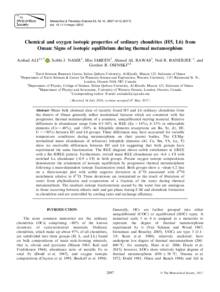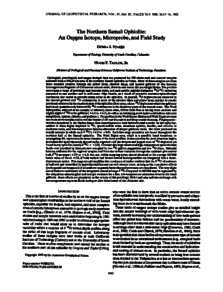Document
Chemical and oxygen isotopic properties of ordinary chondrites (H5, L6) from Oman : signs of isotopic equilibrium during thermal metamorphism.
Identifier
DOI: 10.1111/maps.12910
Source
Meteoritics and Planetary Science. v. 52, 10, p. 2097-2112
Contributors
Nasir, Sobhi J. , Author
Jabeen, Iffat., Author
Al-Rawas, Ahmed., Author
Banerjee, Neil R. , Author
Osinski, Gordon R., Author
Country
United States.
Publisher
University of Arkansas.
Gregorian
2017-10-01
Language
English
Subject
English abstract
Mean bulk chemical data of recently found H5 and L6 ordinary chondrites from the deserts of Oman generally reflect isochemical features which are consistent with the progressive thermal metamorphism of a common, unequilibrated starting material. Relative differences in abundances range from 0.5–10% in REE (Eu = 14%), 6–13% in siderophile elements (Co = 48%), and >10% in lithophile elements (exceptions are Ba, Sr, Zr, Hf, U = >30%) between H5 and L6 groups. These differences may have accounted for variable temperature conditions during metamorphism on their parent bodies. The CI/Mg-normalized mean abundances of refractory lithophile elements (Al, Ca, Sm, Yb, Lu, V) show no resolvable differences between H5 and L6 suggesting that both groups have experienced the same fractionation. The REE diagram shows subtle enrichment in LREE with a flat HREE pattern. Furthermore, overall mean REE abundances are ~0.6 × CI with enriched La abundance (~0.9 × CI) in both groups. Precise oxygen isotope compositions demonstrate the attainment of isotopic equilibrium by progressive thermal metamorphism following a mass-dependent isotope fractionation trend. Both groups show a ~slope-1/2 line on a three-isotope plot with subtle negative deviation in ∆17O associated with δ18O enrichment relative to δ17O. These deviations are interpreted as the result of liberation of water from phyllosilicates and evaporation of a fraction of the water during thermal metamorphism. The resultant isotope fractionations caused by the water loss are analogous to those occurring between silicate melt and gas phase during CAI and chondrule formation in chondrites and are controlled by cooling rates and exchange efficiency.
ISSN
1086-9379
Category
Journal articles



